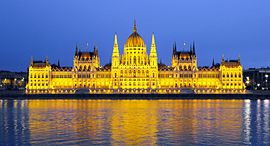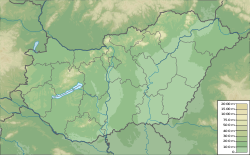Budapest
Budapest | |
|---|---|
| Capital City of Hungary Magyarország fővárosa | |
Clockwise from top: the Danube with Matthias Church in the background, Buda Castle seen from Gellért Hill, Hungarian Parliament, Heroes' Square, St. Stephen's Basilica | |
| Nicknames: Heart of Europe, Queen of the Danube, Pearl of the Danube, Capital of Freedom, Capital of Spas and Thermal Baths, Capital of Festivals | |
| Coordinates: 47°29′33″N 19°03′05″E / 47.49250°N 19.05139°E | |
| Country | Hungary |
| Region | Central Hungary |
| Unification of Buda, Pest and Óbuda | 17 November 1873 |
| Government | |
| • Type | Mayor – Council |
| • Body | General Assembly of Budapest |
| • Mayor | Gergely Karácsony (Dialogue) |
| Area | |
| • Capital city | 525.2 km2 (202.8 sq mi) |
| • Urban | 2,538 km2 (980 sq mi) |
| • Metro | 7,626 km2 (2,944 sq mi) |
| Elevation | Lowest (Danube) 96 m Highest (János Hill) 527 m (315 to 1,729 ft) |
| Population | |
| • Capital city | 1,752,286[1] |
| • Rank | 1st (9th in EU) |
| • Density | 3,388/km2 (8,770/sq mi) |
| • Urban | 2,997,958[5] |
| • Metro | 3,011,598[4] |
| Demonyms | Budapester, budapesti (Hungarian) |
| Time zone | UTC+1 (CET) |
| • Summer (DST) | UTC+2 (CEST) |
| Postal code(s) | 1011–1239 |
| Area code | 1 |
| ISO 3166 code | HU-BU |
| NUTS code | HU101 |
| HDI (2018) | 0.901[9] – very high · 1st |
| Website | BudapestInfo Official Government Official |
| Official name | Budapest, including the Banks of the Danube, the Buda Castle Quarter and Andrássy Avenue |
| Criteria | Cultural: ii, iv |
| Reference | 400 |
| Inscription | 1987 (11th Session) |
| Extensions | 2002 |
| Area | 473.3 ha |
| Buffer zone | 493.8 ha |
Budapest is the capital and largest city of Hungary. It was made as such in 1873. In that year, three towns on the River Danube, namely Buda, Óbuda (Old Buda) and Pest were united. About 1.7 million people live in the city. Its highest place is János Hill (527 m).
Gallery[change | change source]






Climate[change | change source]
Budapest has a humid subtropical climate with relatively cold winters and quite warm summers.[10]
History[change | change source]
Celtic tribes lived there before 1 AD. Later, the Roman Empire transformed the first settlements into the Roman town of Aquincum. The Hungarians arrived in the territory of modern Hungary only at the end of 9th century AD.
Budapest also became the co-capital of the Austro-Hungarian Empire,[11] a great power that dissolved in 1918 after World War I. The city was the focal point of the Hungarian Revolution of 1848, the Battle of Budapest in 1945, and the Hungarian Revolution of 1956.[12][13]
Landmarks[change | change source]
Budapest has historical buildings, baths and parks.
The Roman Catholic cathedral, St. Stephen's Basilica, is in the 5th district of Budapest. The church is a Neo-Renaissance-style cathedral. It is one of the most significant church buildings in Hungary. The building is named in honor of the Hungarian founding king, St. Stephen (975-1038), whose right hand, the Holy Right, is kept here as a relic. With a height of 96 meters, it is the fourth-tallest building in the country and the third tallest in the capital after the Parliament and the MOL Campus.
The former royal palace, the Buda Castle -as part of the Castle District- has been part of Budapest's World Heritage Sites since 1987. The Gothic-style royal palace was built in the 1300s and lasted until the end of the 1400s. Due to the Turkish occupation from 1541 to 1686, very serious damage was done to both the castle and the buildings of the Castle District. In the building of the palace, the National Széchényi Library has been located in the back, decorated with Art Nouveau elements, and the Hungarian National Gallery and the Budapest History Museum are located in the palace.
Also on the Castle Hill, the Matthias Church is a Gothic church with a great historical past. It was originally built in Romanesque style in 1015, but was destroyed during the Mongol invasion in 1241. The current building was built in the 14th century and underwent a thorough reconstruction in the late 19th century. After the occupation of Buda, the church was transformed into a mosque, during which the late Gothic frescoes inside the church were destroyed. After the liberation of Buda, according to the plans of Frigyes Schulek, it was restored to its second, Gothic state. During the Second World War, it was used as a camp by the Germans and the Soviets during the siege of Budapest.
The Hungarian Parliament Building, also known as the Parliament of Budapest after its location, is the seat of the National Assembly of Hungary, a notable landmark of Hungary, and a popular tourist destination in Budapest. It is situated on the Kossuth Lajos Square in the Pest side of the city, on the eastern bank of the Danube. It was designed by Hungarian architect Imre Steindl in neo-Gothic style and opened in 1902. It has been the largest building in Hungary since its completion, and the third biggest Parliament building in the world.
Further north, the building of the National Police Headquarters (in the common language “Police-Palace”) located in the Árpád Göncz City Center. Since its completion, its shape and size have been one of the defining buildings of the whole of Budapest in terms of cityscape. The plans were completed in the 1990s by József Finta and Géza Meichl, and their construction was financed by Postabank collaborating with the Hungarian police. 36,000 cubic meters of concrete and 4.5 thousand tons of rebar were used for the construction. The headquarters can be divided into two parts, one eight-story and columnar and the other sixteen stories and cylindrical, with police antennas at the top that extend 93 meters high. In 2007, an unknown person fired at the building with a machine gun.
On the south, in the 10th district of Budapest, located the transmission tower on Száva Street. With a height of 154 meters, it is the third-tallest structure in Budapest (after the Mount Széchenyi TV mast and the chimney of Óbuda Power Plant). The tower is well visible from the southern Pest region of the capital, but it can be seen in several lookouts of Buda too. It was built in 1987, and it is currently owned by Hungarian Telekom. As a backbone transmitter, it broadcasts digital terrestrial radio (T-DAB +) and digital television channels (DVB-T standard, MinDig TV and mobile phone DVB-H).
Other landmarks in Budapest are the Citadel, the Statue of Liberty, the Millenium Monument, the Zoo, the Hungarian National Museum, the Great Market Hall, the Dohány Street Synagogue and the famous thermal baths (Széchenyi, Szent Gellért, Király). Budapest is also known for the ruins of Aquincum, the capital city of the Roman Province of Pannonia.
Trivia[change | change source]
It has the oldest subway-line in mainland Europe.[14]
Twin cities of Budapest:
- Beijing CN
- Berlin DE
- Bethlehem
- Florence IT
- Fort Worth US
- Frankfurt am Main DE
- Kraków PL
- Lisbon, PT
- New York US
- Sarajevo BA
- Shanghai CN
- Skopje MK
- Subotica RS
- Târgu Mureș RO
- Tehran IR
- Tel-Aviv IL
- Vienna AT
- Zagreb HR
References[change | change source]
- ↑ "Population by type of settlement – annually". Hungarian Central Statistical Office. 12 April 2016. Retrieved 12 April 2016.
- ↑ "The Municipality of Budapest (official)". 11 September 2014. Retrieved 11 September 2014.
- ↑ "Budapest". Encyclopædia Britannica. 11 September 2014. Retrieved 11 September 2014.
- ↑ "Metropolitan Area Populations". Eurostat. 21 October 2019. Retrieved 18 November 2019.
- ↑ "Functional Urban Areas – Population on 1 January by age groups and sex – 2019". Eurostat. 2020. Retrieved 18 November 2019.
- ↑ "Best view in Budapest from the city's highest hilltop". stay.com – Budapest. 11 September 2014. Archived from the original on 23 June 2010. Retrieved 11 September 2014.
- ↑ "Gazetteer of Hungary, Hungarian Central Statistical Office, 2012" (PDF). Retrieved 2 October 2013.
- ↑ "Budapest City Review". Euromonitor International. December 2017. Retrieved 8 May 2014.
- ↑ "Sub-national HDI - Subnational HDI - Global Data Lab". globaldatalab.org.
- ↑ Peel, M. C.; Finlayson, B. L.; McMahon, T. A. (18 July 2010). "World Map of Köppen-Geiger climate classification". The University of Melbourne. Retrieved 26 April 2013 – via WikiMedia commons.
- ↑ Alexander Watson, Ring of Steel: Germany and Austria-Hungary at War, 1914–1918 (2014). pp 536–40.: In the capital cities of Vienna and Budapest, the leftist and liberal movements and opposition parties strengthened and supported the separatism of ethnic minorities.
- ↑ UN General Assembly Special Committee on the Problem of Hungary (1957) "Chapter II.C, para 58 (p. 20)" (PDF). (1.47 MB)
- ↑ John Lukacs (1994). Budapest 1900: A historical portrait of a City and its culture. Grove Press. p. 222. ISBN 978-0-8021-3250-5.
- ↑ 10 Facts You May Not Know About Budapest
Other sources[change | change source]
- Evans, R.J.W. Austria, Hungary, and the Habsburgs: Central Europe c.1683–1867 (2008) doi:10.1093/acprof:oso/9780199541621.001.0001 online
- Herman, Arthur. What life was like: at Empire's end : Austro-Hungarian Empire 1848–1918 (Time Life, 2000); heavily illustrated.
- Kann, Robert A. A History of the Habsburg Empire: 1526–1918 (U of California Press, 1974); highly detailed history; emphasis on ethnicity
- Oakes, Elizabeth and Eric Roman. Austria-Hungary and the successor states: a reference guide from the Renaissance to the present (2003)
- Katzenstein, Peter J. (1976). Disjoined partners: Austria and Germany since 1815. University of California Press. ISBN 9780520029453.
- Ungvary, Krisztian (2006). The Siege of Budapest: one hundred days in World War II. Yale University Press. ISBN 978-0-300-11985-5.
- Molnar, Miklos (2001). A concise history of Hungary. Cambridge Concise Histories. Cambridge University Press. ISBN 978-0-521-66736-4
Other websites[change | change source]
- Budapest Holidays Archived 2017-04-26 at the Wayback Machine
- Budapest tourism info Portal
- History of Budapest Archived 2007-03-17 at the Wayback Machine
- Budapest map Archived 2007-09-27 at the Wayback Machine
- WorldFlicks in Budapest: Photos and interesting places on Google Maps Archived 2008-09-18 at the Wayback Machine









